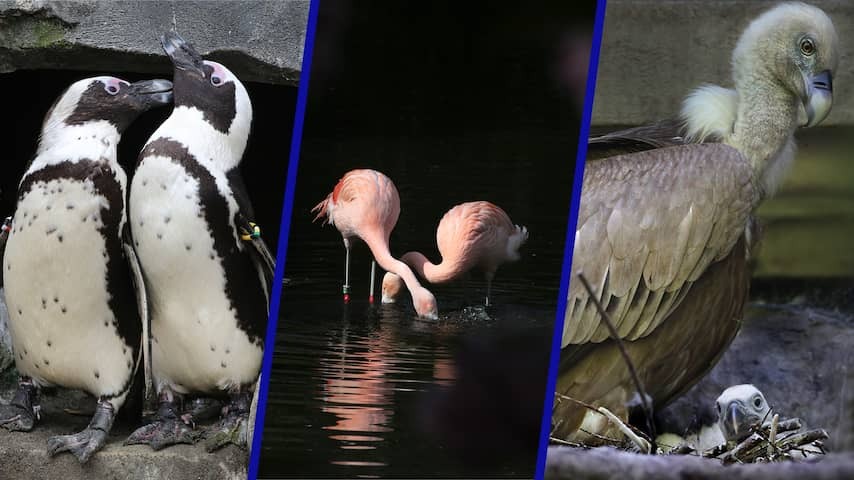
Homosexuality is unnatural, some NUjij users claim under, for example, posts about the pride. But experts tear that statement apart. “Any behavior that animal species exhibit in nature is by definition natural.” And the sexual diversity is great.
Different sexual preferences, gender changes, or the absence of a gender: it can all be found in nature. “Homosexual behavior has already been observed in fifteen hundred species of birds and mammals,” writes ARTIS Zoo in an announcement of a tour on the theme. Saar Bakker is responsible as an educator for the content of it.
When Bakker took on that role 3.5 years ago, she was surprised how sexually diverse nature is. “That it occurs so incredibly often and that I knew absolutely nothing about it,” Bakker tells NU.nl. “Especially because for me it feels like by far the strongest argument against the claim that homosexuality is unnatural.” In nature, the opposite is true.
“It is difficult to determine in animals that they are gay, because we cannot ask them,” Bakker emphasizes. That is why experts can only say something about homosexual behavior.
In literature research, José María Gómez found that in 261 mammal species. But homosexual behavior occurs in all animal groups, concludes the evolutionary biologist and ecologist. From invertebrates such as insects and spiders to fish, amphibians, reptiles and birds.
‘Most animals exhibit some form of queer sexual behavior’
Scientists now assume fifteen hundred animal species. “But that number is probably larger,” says primatologist Karyn Anderson. “I think the consensus among most scientists who study this behavior is that most animals engage in some form of queer sexual behavior. And that exclusive heterosexuality is probably very rare.”
According to Anderson, there are a few studies in which the sexual preference of animals has been explicitly tested. In the study, the animals could choose their own partner. “This has been observed in Japanese macaques and in some bird species such as penguins,” says Anderson.
“The best known in the zoo are probably the penguins,” says Bakker. For example, two females sometimes form a trio with a male. If that produces a fertilized egg, they sometimes raise it together. It is also possible that females chase away the male and do the breeding process together.
It also happens that two males adopt an egg. That can be an egg that they find or an egg that zoo staff give them as part of a breeding program.
Regularly homosexual bird couples
Bakker knows many examples of homosexual bird couples. “This works very well with birds, because they often have an equal role in the upbringing,” says Bakker. “With griffon vultures you see that men more often form a couple,” she says. She also sees that sometimes with flamingos. “You often recognize them by a super nest, because the males usually build a nest harder.” These nests are therefore often much larger.
In addition to homosexual behavior, there is also sexual diversity in nature. “Many plants are hermaphroditic,” says Bakker. “That is much more common than that they exist separately.” There are also species that can change sex, such as the black three-banded anemonefish. “That looks a bit like Nemo from the animated film Finding Nemo.”
Three-banded anemonefish are born as undeveloped males. Depending on their rank in the group, they develop into a sperm-producing male. The highest in rank may mate with the female. There is one of those in the group. When she dies, the highest male develops into a female. In other fish species it happens the other way around. There, females become males.
There are also animals with both male and female sexual characteristics. Intersexes occur in deer, bears and kangaroos, among others. For example, wallaby females usually have a vagina and pouch with nipples in it. Males have a penis with scrotum and no pouch. But there are also animals with a pouch that can give milk like a female, but also have a penis.
“Actually, it would be stranger if people were not gender diverse,” concludes Bakker. “That would be a more unnatural situation than it is now.”
No justification needed
With this whole explanation, a caveat must be made, Anderson emphasizes. “Lgbtqia + people do not need justification.” That is why she wants to guard against observations of homosexual behavior in the animal kingdom being used as justification for human behavior.
Precisely many homophobic statements were based on the argument that what happens in nature is good or normal. “Of course these people were wrong. Homosexuality is very natural,” says Anderson. But she thinks it is important to see those two things separately.
“As a queer person, I like to see myself reflected in nature,” says Anderson. In addition, she thinks it is important that incorrect information is corrected. “But the existence of queers does not have to be justified by evolutionary biologists. We just exist.”